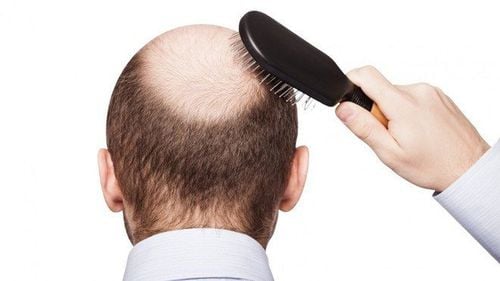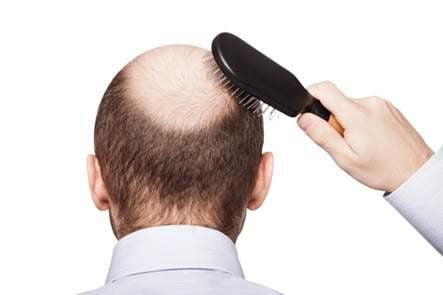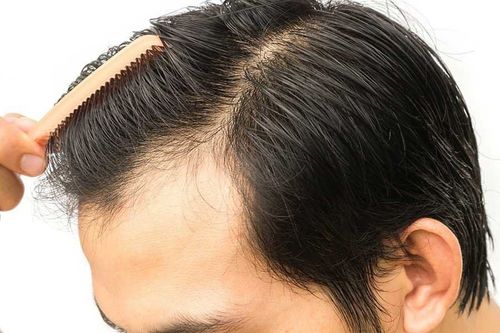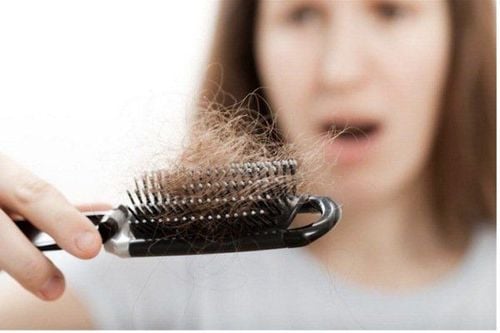This is an automatically translated article.
Hair loss is a condition that occurs when the amount of hair falling out is more than the amount of hair growing daily. Many cases of excessive hair loss are caused by hair not continuing to grow, leading to baldness, which is common in men. To treat hair loss, medications, hair transplant therapy, or laser therapy can be used.
1. Who is prone to hair loss?
Hair loss can affect only the scalp or the entire body (alopecia). The cause of a lot of hair loss is often genetics, hormonal changes, medical conditions or unwanted drug effects. Anyone can experience hair loss. However, male hair loss is more common than female hair loss.
The following people are often at high risk of hair loss, including:
There is a family member with baldness, possibly a relative on the father's or mother's side; advanced age; Lose Weight Fast; Have certain medical conditions, such as diabetes and cutaneous lupus; Have a lot of stress.

Many cases of excessive hair loss due to age factors, leading to baldness. Heredity is the most common cause of this condition.
Some people prefer to let their hair loss happen naturally, not treating it or trying to hide it. Others may cover their bald heads with wigs, decorations, hats, or scarves. However, a lot of other people choose one of these treatments to prevent hair loss and restore hair growth.
Before deciding to treat hair loss, consult with your doctor to find out the cause of your hair loss and the right treatment options.
Trắc nghiệm: Bận rộn có ảnh hưởng đến sức khỏe của bạn không?
Cuộc sống hiện đại khiến chúng ta vì quá bận rộn mà quên chăm sóc sức khỏe cho chính mình. Ai cũng biết rằng lịch trình làm việc cả ngày có thể khiến bạn kiệt sức, nhưng cụ thể bận rộn ảnh hưởng thế nào tới sức khỏe? Hãy cùng làm thử bài trắc nghiệm dưới đây.
2. Causes of hair loss
The average person loses about 100 hairs a day, but this usually doesn't have a significant effect because new hair will grow in parallel. As such, hair loss occurs when this hair growth cycle is interrupted or when the hair follicle is destroyed and replaced by scar tissue, causing more hair to fall out than it grows on a daily basis.
Hair loss is usually related to one or more of the following factors:
Family history (heredity): The most common cause of male hair loss is genetics, which causes male pattern baldness. Sometimes this cause is also found in some cases of female hair loss. This condition often occurs in tandem with aging and is almost predictable in hair morphology over time (appearance of bald spots for male alopecia and thinning of hair for female alopecia); Hormonal changes and medical conditions: A variety of hormone-related disorders can cause permanent or temporary hair loss, including hormonal changes during pregnancy, childbirth, menopause, and problems with Thyroid. Pathological causes include alopecia areata (alopecia areata), scalp infections such as ringworm, and a syndrome called “trichotillomania”; Medications and supplements: Hair loss can be caused as a side effect of certain medications, such as cancer drugs, arthritis, depression, heart disease, high blood pressure, and gout medications; Radiation therapy to the head: The hair is at risk of not being able to grow back as before; Stress: Many people experience severe hair loss after receiving a physical or emotional shock. This type appears only temporarily; Certain Hairstyles and Treatments: Unusual "hairdos" or tight hair ties, such as braids or cornbows, may be to blame. cause hair loss. In addition, long-term application of hair treatments (such as hot oils) can cause inflammation of the hair follicles, leading to hair loss. If scarring occurs, permanent hair loss is possible.
3. Methods to cure hair loss

Currently, there are many effective treatments for hair loss in both men and women. You can completely reverse hair loss or at least slow it down. With some medical conditions, such as alopecia areata, hair can regrow without any treatment within a year.
Treatments for hair loss include the use of drugs, surgery to stimulate hair growth and slow hair loss.
3.1. Medication Use If hair loss is caused by an underlying disease, it's essential to diagnose and treat that condition. Treatment may include medications to reduce inflammation and suppress the patient's immune system, such as prednisone. If a certain medication has the potential to cause hair loss, your doctor will advise you to stop taking it for at least three months.
Medications to treat (hereditary) baldness include:
Minoxidil (brand name Rogaine): This is an over-the-counter medication approved for the treatment of male and female hair loss. The drug is in the form of a liquid or foam, applied to the scalp daily. At first, the medicine may cause you to lose your hair. New hair may be shorter and thinner than old hair. However, patients need to persist for at least 6 months of treatment to prevent hair loss and for hair to start growing back. Patients need to continue taking Minoxidil to maintain the hair loss benefits; Finasteride (brand name Propecia): This is a prescription drug, approved for male hair loss. The form of the drug is in pill form. Finasteride works to slow hair loss for most men, and some even find it stimulating to grow new hair. This medicine may not be as effective for men over 60 years of age. Patients need to take Finasteride continuously to maintain the hair loss benefits; Other medications as appropriate: For men with hair loss, oral dutasteride is an appropriate option. For women with hair loss, treatment with oral contraceptives and spironolactone can prevent hair loss. 3.2. Hair Transplant Surgery In cases where the patient has permanent hair loss and usually only the top of the head is affected, a hair transplant technique or restorative surgery can make the most of the patient's remaining hair.
During a hair transplant, a dermatologist or plastic surgeon removes small patches of the scalp (each containing one to several hairs) at the back of the patient's head or around the head. Then, the doctor performs a hair follicle transplant on the bald part at the top of the head. Some doctors recommend Minoxidil after a transplant to help minimize hair loss. Sometimes patients have to undergo surgery many times to achieve the desired effect.
Even with a hair transplant, genetic hair loss will still occur. Techniques to treat baldness are often quite expensive and painful. Risks include bleeding and scarring.
3.3. Laser therapy The U.S. Food and Drug Administration (FDA) has approved laser therapy to treat hereditary hair loss in men and women. A few small studies have shown that this method improves hair density. However, more research is needed to demonstrate long-term effects.
4. Remedies for hair loss
If you already have a lot of hair loss and want to overcome the consequences of this condition, you can use supporting products, such as scarves or wigs. Speak with a stylist to get ideas for your “new hair.” These non-medical solutions can be used in the long-term treatment of hair loss.
When you notice a lot of hair loss, you need to see a doctor to determine the exact cause, then you can find ways to improve or treat accordingly. When the cause of hair loss has not been determined, patients should not arbitrarily use antifungal drugs, topical drugs or drugs for hair loss of unknown origin.
Please dial HOTLINE for more information or register for an appointment HERE. Download MyVinmec app to make appointments faster and to manage your bookings easily.
Reference source: Mayoclinic.org












